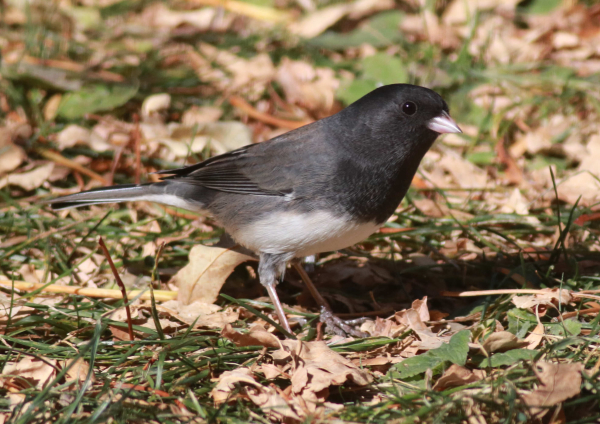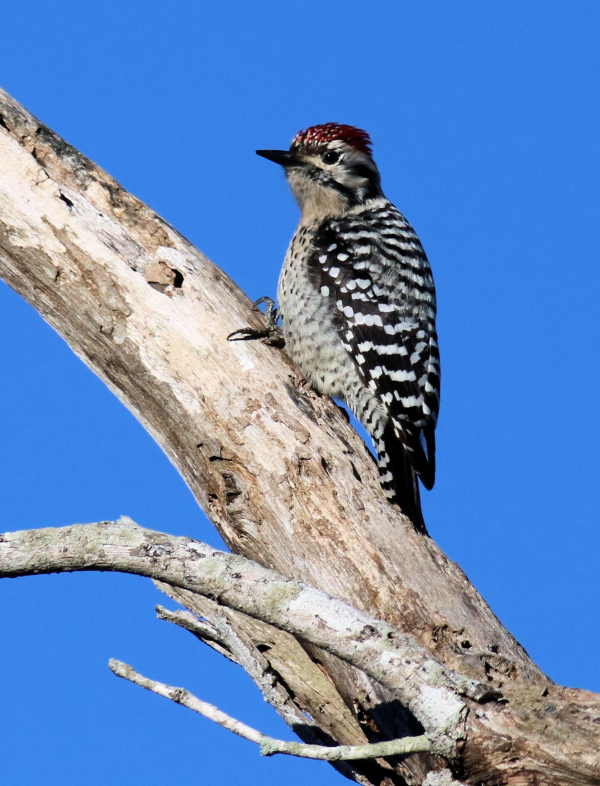
You can attract more ground-oriented birds, like this Dark-eyed Junco, by leaving an area where you don’t rake the leaves, which can also attract a variety of native sparrows, thrashers, thrushes, doves, and other birds (photos by Paul Konrad).

A dead branch is very attractive to a variety of birds as a perch and singing location, while woodpeckers like this Ladder-backed Woodpecker, use it for foraging as well as territorial drumming.
|
As we try to attract more birds during fall and post-fall, it’s a good time to consider what more we can do to attract a greater variety of birds, including birds that we don’t normally see. Many of the birds filtering into our neighborhoods and yards are looking for specific foraging areas that provide a combination of cover and “messy” areas where they can search for food. It may be as simple as leaving an area where you don’t rake or pick up the leaves so native sparrows, juncos, thrashers, thrushes, doves, and other birds have a place to turn over leaves to find insects, spiders, and other invertebrates, as well as seeds and tender plant parts.
Similarly, leaving some of your lawn un-mowed – maybe a few stands of grass, an edge of grass around bushes, a border of grass along a part of one side of a hedge, around the base of some of your trees. It may seem “messy” at first, but you will probably realize these added grassy areas will become decorative grass that will become a darker shade of green compared to your mowed grass, and when they form seed heads they add another decorative element that will feed native birds and provide islands of cover for ground-oriented birds. You may even entice quail or partridges into your yard – that’s always a thrill.
Branches & Trees
Keeping with the messy theme, it’s always good to leave a large dead branch on a tree, as long as it doesn’t endanger your house or other outdoor living areas. Dead branches and tree trunks are very attractive to woodpeckers, nuthatches, creepers, and other birds. They also provide important perches for all birds, but especially swallows, doves, and other birds that prefer open perches, as well as hunters including flycatchers, kingbirds, small owls, kestrels, small hawks, and more.
Some birders take the dead branch and tree trunk theme a step farther and “plant” dead tree parts in their yard. These elements can also be decorative, in that you can pick out the dead branch or trunk to add to your yard, and you can position it just where you wish. You can either anchor the tree section by burying the base of it securely in the ground, or you can attach it to an existing anchored structure, a short post for instance.
You can also attach a big branch vertically to a post or metal bar you anchor in the ground. With smaller branches, that effort can be as simple as securing a nice-looking branch with wire onto a shepherd’s crook that is anchored in the ground. If you have a shepherd’s crook already installed at your feeding station, you can add a decorative branch to give your feeding station a more natural look by securing the vertical branch with metal wire. Then too, it’s always good to provide a perch near your feeders – say 10 or 15 feet away – to give birds a place to land as they approach the feeders. Give it a try, you may be surprised at how it adds to your yard and feeding area.
So, in many cases, messy can really become decorative, and if you make a few adjustments to your usual yard care options this fall, more birds will benefit from your thoughtful changes. Likewise, you will benefit by seeing new birds to add to your yard list, and hopefully attract year after year. Backyard habitats are extremely important areas for birds – migrating birds, wintering birds, and nesting birds – all in season. Keep up your great work to benefit birds by providing food, water, landscaping, and more!
Share your backyard birding experiences and photos at editorstbw2@gmail.com